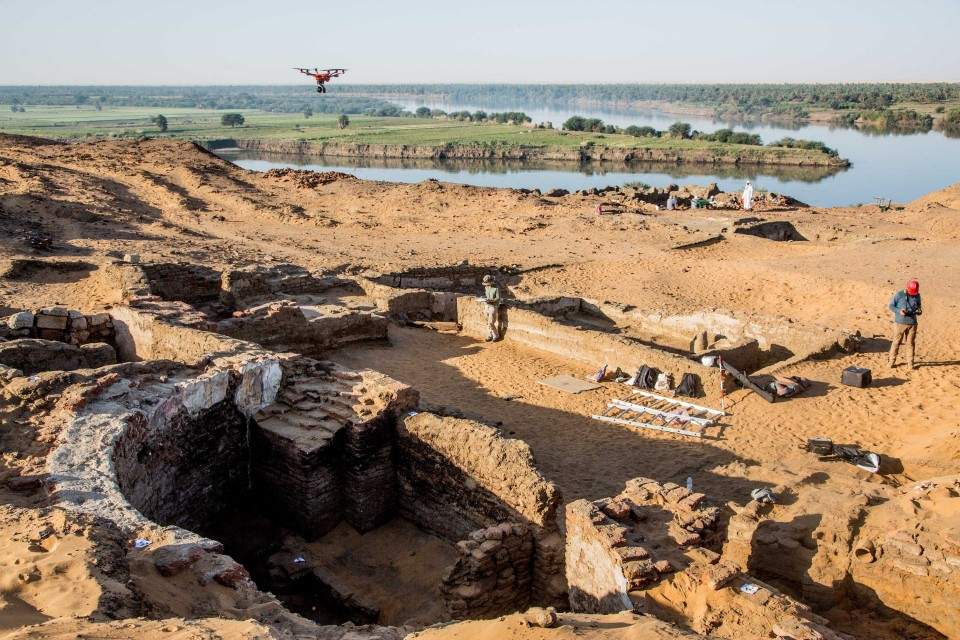Sudan, remains of an imposing cathedral discovered: possibly the largest in ancient Nubia
Important archaeological discovery in Sudan: a Polish team from the Centrum Archeologii Åšródziemnomorskiej (Center for Mediterranean Archaeology) atWarsaw University has indeed found, at the site of Old Dongola, the remains of what may be the largest known church in medieval Nubia. The church in question may have been the seat of an archbishop who ruled the ecclesiastical hierarchy over a territory that stretched over a thousand kilometers along the banks of the Nile, between the first and fifth cataracts. According to Professor Artur ObÅ‚uski, leader of the expedition to Dongola and director of the Polish Center for Mediterranean Archaeology at Warsaw University, this discovery changes not only our knowledge of the city itself, but also the way we reconstruct the history of the Nubian church.
Dongola was the capital of Makuria, one of the three Nubian Christian kingdoms. Polish archaeologists have been working on this site since 1964, continuing the research begun then by Professor Kazimierz Michałowski after the successes of his work in another Nubian center, Faras, the capital of the kingdom of Nobadia. The newly discovered structures are located in the very center of the ancient city. The walls of the apse, which was the most sacred place in the church, are decorated with paintings depicting two orders of monumental figures. It is the largest apse so far discovered in Nubia: it has a diameter of 6 meters, and the width of the church to which it belonged is about 26 meters. A tomb surmounted by a large dome was also found next to it.
The newly discovered building is located in the center of the citadel, which is surrounded by a wall about 10 meters high and 5 meters thick. Excavations have shown that this was the heart of the entire Makuria kingdom, as all the structures discovered were monumental in nature: churches, a palace and large villas belonging to ecclesiastical and secular elites.
“If our estimates based on the known dimensions are confirmed,” says Artur ObÅ‚uski, “this is the largest church so far discovered in Nubia. Its size is important, but so is the location of the building, in the heart of a 200-hectare city, capital of the combined kingdoms of Nobadia and Makuria. Just east of the apse a large domed building was added. We have a great analogy for a similar architectural complex-Faras. There, too, the cathedral stood in the center of the citadel, and east of it was the domed tomb of Joannes, bishop of Faras. However, there is a big difference in the scale of the buildings. The dome above Joannes’ tomb is 1.5 meters in diameter, while the dome above Dongola’s building is 7.5 meters.”
Archaeologists speculate that, just as at Faras, the large church at Dongola served as a cathedral, and just as at Faras near the cathedral a tomb of dignitaries, probably bishops, was erected. Confirmation of this hypothesis will have significant consequences for Nubian studies. Until now, another church located outside the citadel was considered to be the Dongola Cathedral: it is a building whose features would have influenced Nubian religious architecture over the centuries. “If we are right, it was a completely different building that set the trend,” says ObÅ‚uski.
The next step will be to work on the conservation of the paintings unearthed in the complex: conservators from the Department of Conservation and Restoration of Works of Art at the Warsaw Academy of Fine Arts, working under the supervision of Professor Krzysztof Chmielewski, will be in charge of this phase. Their immediate task is to secure the discovered paintings on an ongoing basis and, in the long term, to prepare them for exhibition. Unlike Faras, they can be left on the church walls. “In order to continue the excavations,” Professor Chmielewski explains, “the wall plaster, which is weakened and peeling, must be reinforced, and then carefully cleaned of layers of soil, dirt and salt deposits that are particularly harmful to the wall paintings. When a suitable cover is constructed for this valuable find, it will be possible to begin the final aesthetic conservation of the paintings.” The next excavation campaigns at Dongola are scheduled for the fall of this year and the winter of 2022.
Pictured are the remains of the cathedral
 |
| Sudan, remains of an imposing cathedral discovered: possibly the largest in ancient Nubia |
Warning: the translation into English of the original Italian article was created using automatic tools. We undertake to review all articles, but we do not guarantee the total absence of inaccuracies in the translation due to the program. You can find the original by clicking on the ITA button. If you find any mistake,please contact us.




























